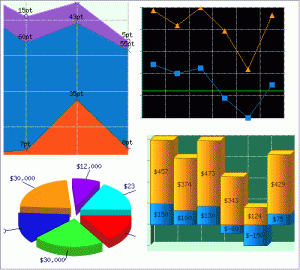To me a photograph plays a powerful role when it comes to remembering an experience from the past. I am able to look back at a photo and remember an experience. This would not be the same if I were not to have a photo to remind me. However, a photo can be deceiving. One may look happy but in reality can be faking that smile. In a way, I feel as though online data displays have the same power as photographs do.
 Charles Kostelnick, a professor at Iowa State University, reports how data displays act as rhetoric in his article “The Visual Rhetoric of Data Displays: The Conundrum of Clarity.” He explains how data displays have changed dramatically in the past 50 years. We now see charts everywhere! As the internet grows so have data displays online. Data can be visualized in so many different ways such as three dimensional displays, pie charts, donut chart, mountain charts, line graphs, scatter plot, etc. They all can act as rhetoric by facilitating the reader’s comprehension of the data. Many are truthful but many others are only telling half of the truth. Since most people tend to believe everything they see in data and charts people can manipulate the charts for their own ends.
Charles Kostelnick, a professor at Iowa State University, reports how data displays act as rhetoric in his article “The Visual Rhetoric of Data Displays: The Conundrum of Clarity.” He explains how data displays have changed dramatically in the past 50 years. We now see charts everywhere! As the internet grows so have data displays online. Data can be visualized in so many different ways such as three dimensional displays, pie charts, donut chart, mountain charts, line graphs, scatter plot, etc. They all can act as rhetoric by facilitating the reader’s comprehension of the data. Many are truthful but many others are only telling half of the truth. Since most people tend to believe everything they see in data and charts people can manipulate the charts for their own ends.
Even I am easily fooled when it comes to believing data online. When an article contains a photograph or chart, I find it more appealing than if it weren’t to have it. It is the first thing I look at before even reading the material. Even after I finish reading the content, I am likely to to remember the chart/ photograph more than the material I had just read. Unfortunately, it has never even crossed my mind that the information in data that I have seen has been false. Another problem that data displays have is how people interpret the data.
“The physical, perceptual, and historical context in which the display is read will also affect the reader’s interpretation of the data. Depending on the immediate environment in which the display appears—in a board room presentation, buried in a report, or online—readers may have different perceptual and interpretive experiences…”
Each person will take in the information differently from others depending on the way the data was displayed or where it was shown to the viewer. For the most part, data displays are very helpful especially for visual learners. If the information displayed is accurate, the data is able to reinvent something that was once complex to reproduce.

